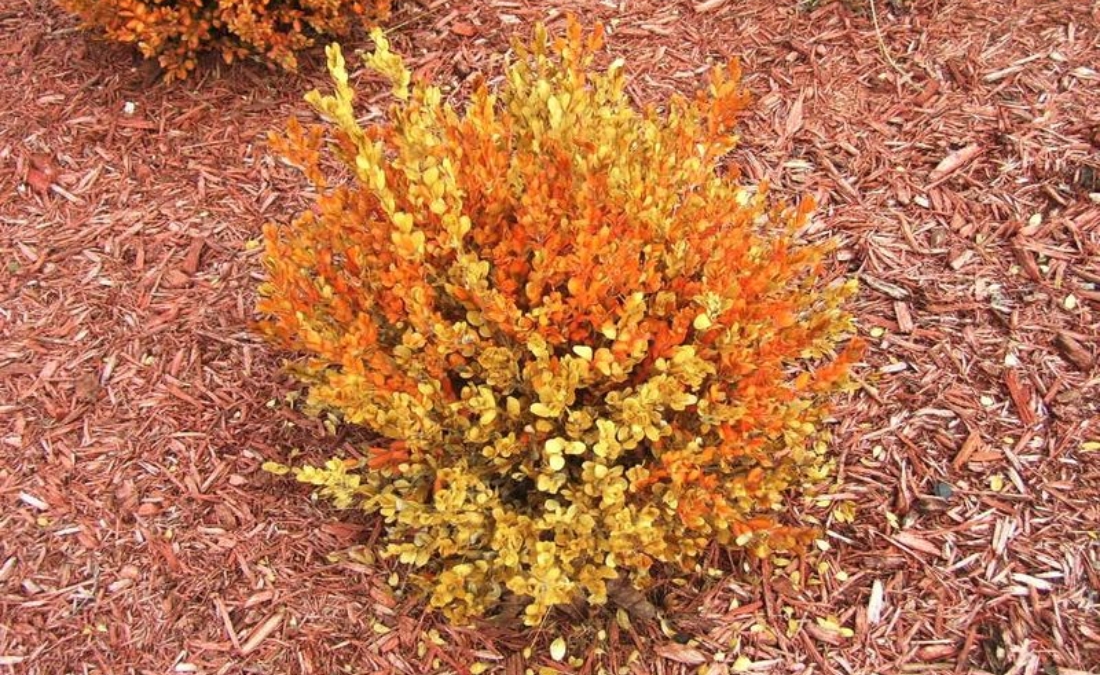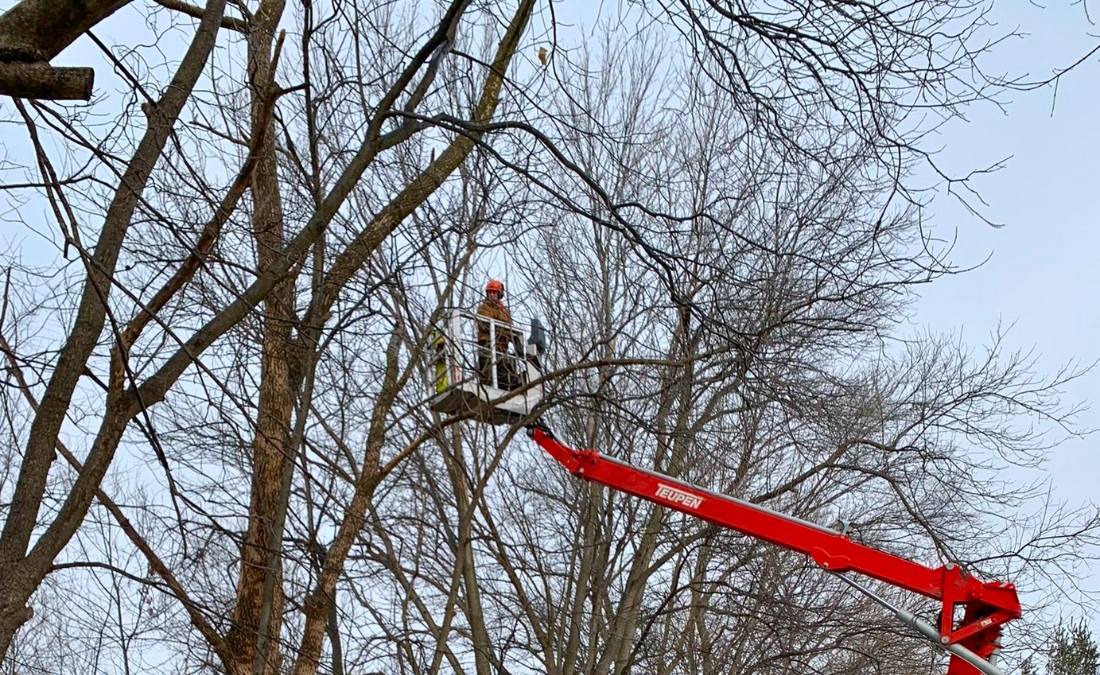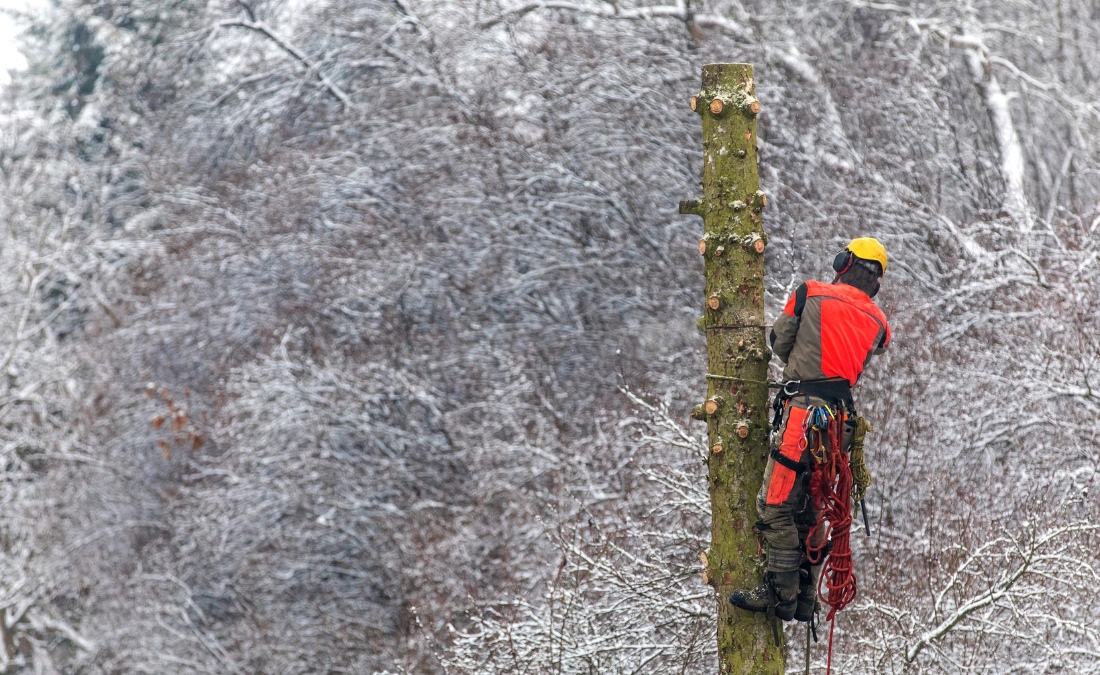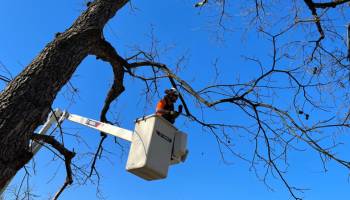Is Your Tree Underwatered? What to Look for and How to Water Properly

Yellowing leaves, thinning canopies, and even fungus may be signs of underwatered trees. Learn what to look for and how to water trees the right way.
Lately, we’ve been getting a flood of calls about what looks like a fungus attacking trees in Des Moines. But when our arborists arrive, they’re noticing something more – yellowing leaves, scorched edges, and dieback on branches. These symptoms usually point to a different issue altogether, and it’s not a disease.
In most cases, the trees we’re called to inspect for fungus are actually struggling because they’re not getting enough water. We’re seeing widespread signs of underwatered trees – not due to neglect, but because shallow, frequent watering that barely keeps the grass green is leaving trees high and dry.
Key Takeaways
- Trees stressed by underwatering become more vulnerable to secondary issues, like pests and fungal infections, because their natural defenses weaken.
- Early symptoms of underwatering include top-down yellowing, premature fall color, tip dieback, and suckers or water sprouts at the base.
- In Des Moines’ clay soil, trees often wilt even when the surface looks damp because the moisture never reaches the root zone.
- Sprinklers and daily hand watering aren’t enough – trees need 10–40 gallons of water once or twice a week, applied slowly at the drip line.
Why Underwatering Makes Trees Vulnerable
So why do underwatered trees develop what looks like fungal diseases? It’s not that underwatering directly causes these problems. Instead, it weakens the tree’s ability to protect itself.
Think of a properly watered tree like someone with a strong immune system. When problems pop up, like a wound or insect damage, it can respond quickly by sealing off injuries, producing protective compounds, and defending itself before things get out of hand.
But when a tree is stressed from improper watering, that natural defense system breaks down. It can’t produce the resins and saps it normally uses to seal wounds and repel insects. Healing slows, wounds stay open longer, and even the tree’s bark and leaves change in ways that attract pests that would usually steer clear of a healthy tree.
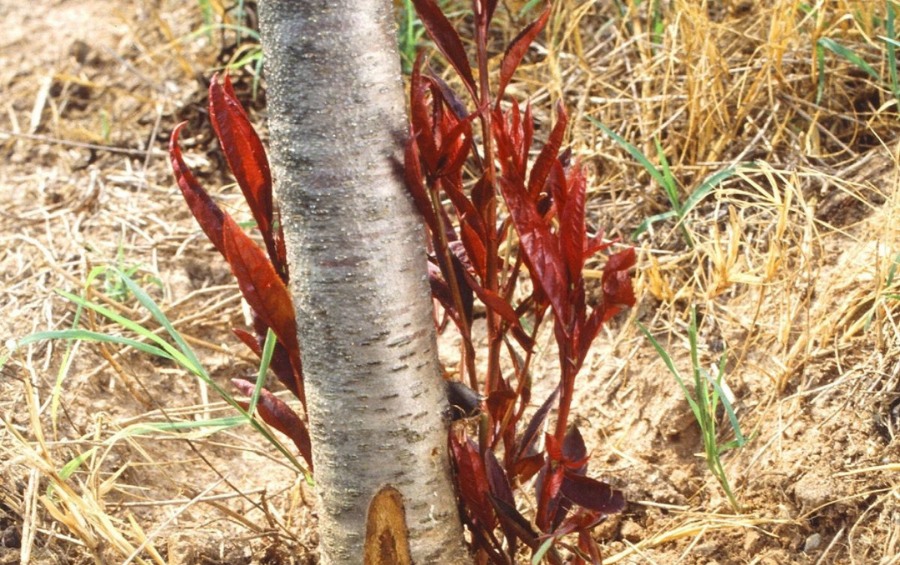
New shoots growing from the base of a tree trunk are a stress response, and a common sign the tree may not be getting enough water. Rob Flynn, Bugwood.org
Common Signs of an Underwatered Tree
Most Des Moines homeowners don’t realize their trees are underwatered until the signs become too obvious to ignore. But trees don’t always show stress in dramatic ways – the early symptoms are subtle and easy to miss. Here are some of the most common signs of underwatered trees you should always be watching for.
- Top-Down Yellowing or Browning: When a tree doesn’t have enough water, it starts to shut down growth in the outer canopy first. You’ll often see leaves at the top ends of branches turn yellow or brown before others.
- Leaf Scorch: Brown, brittle margins are a classic sign that the tree is losing water faster than the roots can replace it. This shows up most often during hot, dry, or windy days – something central Iowa sees plenty of in July and August.
- Premature Leaf Drop or Fall Color: If your tree starts dropping leaves in midsummer or showing reds and oranges well before the overnight temperatures start cooling off, it’s not confused about the season, it’s entering survival mode.
- Tip Dieback: When water is limited, trees prioritize their core structure. That means branch tips, especially those furthers from the trunk or exposed to sun, may die back first.
- Thinning Canopy: If the tree looks unusually “see-through” or sparse, it’s likely conserving energy and water by reducing leaf growth.
- Wilting Despite Moist Soil: Clay soil in Des Moines can hold moisture at the surface but remain dry where the roots actually need it. Trees may wilt even when the top layer looks damp.
- Smaller or Misshapen Leaves: New growth may be undersized or deformed when the tree doesn’t have enough water during key growth periods.
- Bark Cracking or Splitting: In young or recently planted trees, lack of water can cause the bark to crack as the trunk contracts.
- Excessive Suckering: Trees under stress may send up water sprouts or suckers from the base as a survival response, trying to regrow or redirect energy.
- Sudden Appearance of Pests or Fungal Diseases: Stressed, underwatered trees are more vulnerable to secondary problems. When a tree doesn’t have the water it needs, it can’t produce the protective compounds that help seal wounds and defend against insects and pathogens. That makes it easier for borers, beetles, and fungal infections to take hold, even if they’re not the root cause of the problem.
How to Water Trees Properly
Unlike lawns, trees don’t need daily sprinkles – they need deep, thorough watering just once or twice a week during dry spells. That’s because quick, shallow watering encourages shallow roots, which makes trees more vulnerable to stress, disease, and drought.
The Low and Slow Approach
In Des Moines, trees benefit most from slow, steady watering that soaks down to the root zone. Use soaker hoses, drip irrigation, or a hose set to trickle, and let it run for 45-90 minutes depending on the tree’s size. Focus your watering at the drip line – the area directly beneath the outer edges of the canopy – not at the base of the trunk.
In heavy clay soils, consider watering in cycles, such as 20 minutes on and 10 minutes off, to prevent runoff and allow more water to absorb into the root zone.
- Small Trees (under 15 feet): 10-15 gallons per session
- Medium Trees (15-25 feet): 15-25 gallons per session
- Large, Mature Trees (over 25 feet): 25-40 gallons per session
The Best Time to Water Trees
The ideal time to water trees is early in the morning, between 5 AM and 9 AM. Temperatures are cooler, wind is low, and more water can soak deep into the soil instead of evaporating. Avoid watering during the heat of the day when most of the water is lost before it ever reaches the roots.

The yellowing leaves at the top of this mature tree show one of the first signs of stress from underwatering. Karla Salp, Washington State Department of Agriculture, Bugwood.org
Frequently Asked Questions About Underwatered Trees
How quickly will proper watering help an underwatered tree?
You should see improvement in new growth within 2-3 weeks of starting proper watering. However, leaves that are already yellowed or brown won’t recover – focus on preventing further stress and supporting new growth.
Can I overwater a tree that’s been underwatered?
Yes, you can overwater a tree that’s been underwatered, and it’s a common mistake. Gradually increase watering rather than flooding an underwatered tree. Going from too little water to too much can shock the root system and cause additional problems.
Should I fertilize a tree that shows signs of underwatering?
No, avoid fertilizing underwatered trees until they’ve recovered with consistent watering. Fertilizer can actually increase the tree’s water needs and worsen the stress from insufficient watering.
How do I know if my irrigation system provides enough water for trees?
Most lawn irrigation systems provide shallow, frequent watering that’s inadequate for trees. Trees need deep, infrequent watering instead. If your sprinklers only wet the top few inches of soil, your trees likely need supplemental watering.
What if my tree doesn’t improve with better watering?
If symptoms persist or worsen after 4-6 weeks of proper watering, the tree may have developed secondary problems from being underwatered and now needs professional diagnosis.
Don’t Guess – Get a Professional Tree Health Assessment from Arbor Masters
If your trees are showing signs of stress – yellowing leaves, browning edges, thinning canopies – it’s not always easy to tell what’s causing the problem. Underwatering is a common issue, but it’s not the only possibility.
Arbor Masters can evaluate the health of your trees and give you clear, practical guidance on what to do next. If you’re concerned about how your trees are holding up against the heat, drought, or other challenging conditions in Central Iowa, we’re here to help. Give us a call today at 515-218-2025 to schedule an assessment with one of our Certified Arborists.

Get the latest local news, tree care tips, special offers, and company updates directly to your inbox! It's easy to subscribe and there's no spam - we promise.
"*" indicates required fields


